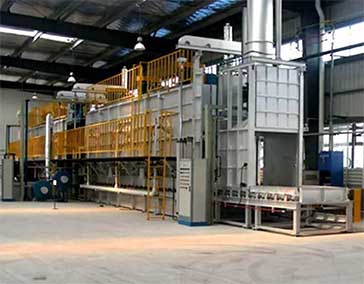Different Material of Car Bottom Type Industrial Furnace Bottom Plate Advantages and Disadvantages
Some clients doubt about the material of car bottom industrial furnace bottom plate, below are their advantages and disadvantages:
1. Heat resistant steel
Cr-Mn-N steel (chromium manganese nitrogen steel)
Applicable temperature: ≤ 850 ℃
Advantages: Strong economy, stable basic high-temperature resistance, and simple processing technology.
Disadvantages: Limited high-temperature oxidation and corrosion resistance, prone to deformation or oxidation peeling under long-term high temperatures.
3Cr24Ni7SiNRe alloy steel
Applicable temperature: 850 ℃~1050 ℃
Advantages: It can replace high chromium nickel steel and has high temperature resistance, corrosion resistance, and creep resistance, with a high cost performance ratio.
Disadvantages: High nickel content leads to increased costs, complex welding processes, and the need for heat treatment.
1Cr25Ni20Si2(310S/2520)
Applicable temperature: 1050 ℃~1200 ℃
Advantages: Ultra high temperature resistance (maintaining strength at 1200 ℃), excellent oxidation resistance, suitable for high load and complex corrosive environments.
Disadvantages: Extremely high cost, difficult processing (requiring precision casting or welding), and heavy weight.
ZG35Cr24Ni7SiN
Applicable temperature: ≤ 1100 ℃
Advantages: High temperature strength exceeding 500MPa, resistance to slag and acid alkali corrosion, and a lifespan of over 10 years.
Disadvantages: The casting process is complex (requiring lost foam or sand casting), with high brittleness and poor impact resistance.

2. Ceramic category
Silicon carbide (SiC) ceramics
Applicable temperature: ≤ 1200 ℃
Advantages: Strong high temperature resistance, high hardness and wear resistance, resistance to molten metal (such as aluminum water) corrosion, lightweight.
Disadvantages: high brittleness, poor resistance to mechanical impact, high cost, and inability to repair through conventional welding.
3. Other special materials
High temperature alloy steel (such as ZG40Cr25Ni20Si2)
Applicable temperature: ≤ 1200 ℃
Advantages: Balanced comprehensive performance, high mechanical strength, and the ability to process complex structures through processes such as centrifugal casting.
Disadvantages: It requires the addition of trace elements (such as Nb, W) to enhance performance, significantly increasing production costs and process difficulty.
4. Comprehensive recommendations
≤ 850 ℃ working condition: Cr-Mn-N steel is preferred to control costs.
850 ℃~1050 ℃: 3Cr24Ni7SiNRe alloy steel is recommended, with a balance between performance and cost.
≥ 1050 ℃: 310S or silicon carbide ceramics are required, with the former suitable for load-bearing scenarios and the latter suitable for wear-resistant and corrosive environments.
Extreme corrosion/lightweight requirements: Silicon carbide ceramics are preferred, but structural protection needs to be strengthened.
BAI KA Copyright © 2025 ALL rights reserved